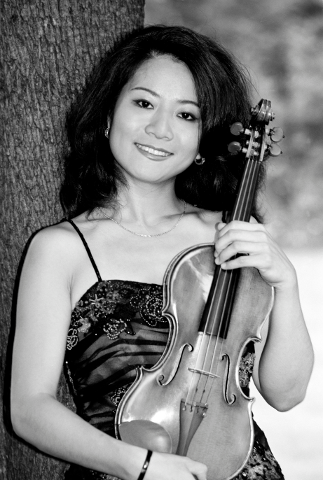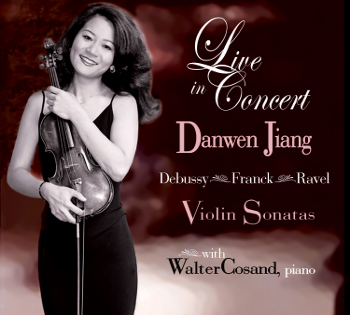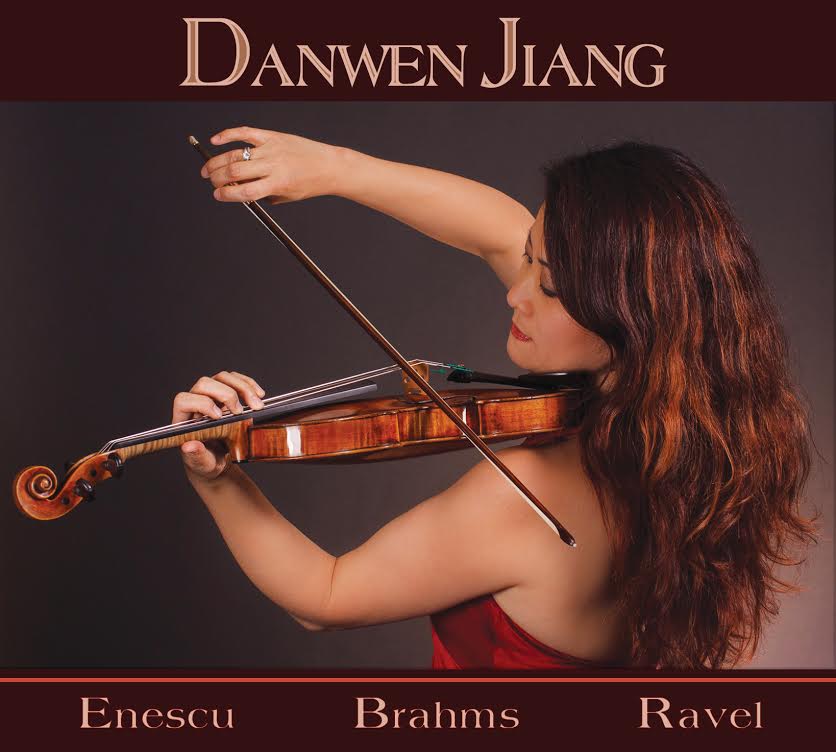
Fine Classical, Instrumental, and Specialty Recordings
Label: Soundset Recordings Item Number: SR1045 Format: CD Year Recorded: 2004 Live in Concert Danwen Jiang Walter Cosand - piano
Danwen Jiang - Violin  A winner of China’s National Violin Competition in 1984, violinist Danwen Jiang has concertized extensively as a concerto soloist and recitalist throughout North America, Europe and Asia, and has performed at world renowned concert venues such as Carnegie Hall, Kennedy Center for the Performing Arts in Washington D.C., La Salle Gaveau in Paris, Beijing Concert Hall, and the Hong Kong Cultural Centre Concert Hall. She has appeared at international music festivals such as Festival du Quercy Blanc and Festival Dan le Gard in France, InterHarmony International Music Festival in Germany and Italy, Harpa International Music Academy in Iceland, Victoria International Music Festival in Canada, Rutgers SummerFest, Sanibel Chamber Music Festival, Yale Chamber Music Series as well as the Manchester Music Festival where she has been an anchor faculty artist since 1993. As an avid chamber musician, she has performed with distinguished musicians including members of the Guarneri, Juilliard, Tokyo, Emerson and Shanghai String Quartets, The Chamber Music Society of Lincoln Center, American Chamber Players, and Soloists of the Pacific Rim as well as violinist Menahem Breuer, cellist Nathaniel Rosen, pianist Andre-Michel Schub, clarinetist Stanley Druker, harpsichordist Igor Kipnis, and Jazz violinist Regina Carter. Her latest CD of Debussy, Frank and Ravel sonatas for violin and piano with pianist Walter Cosand, released in 2012 by Soundset Recordings was described as "Absolutely exquisite" by the Fanfare Magazine. Her performances can also be heard on public radio networks in the United States, Canada and China as well as on Eroica Classical Recordings and China Record Corporation. A recipient of the Professor of the Year Special Recognition Award (2012), President’s Tenured faculty Exemplar Award (2008) and the Distinguished Teaching Award (2005) at Arizona State University, Jiang’s international reputation as an exceptional performer and teacher yields her frequent invitations to perform and present guest master classes at distinguished music institutions around the world, including the Central Conservatory of Music in Beijing, Iceland Academy of the Arts and College of Music in Reykjavík, the State University of Music and Performing Arts Stuttgart in Germany, Vancouver Academy of Music in Canada, Sydney Conservatorium in Australia, and major universities across the United States. She has been a featured concerto soloist and master class clinician for violin at the 2005 and 2008 American String Teachers Association National Conferences. Prior to joining the ASU School of Music faculty, Jiang taught at Oberlin Conservatory of Music and the University of Illinois. Her students have been winners of national and international violin and chamber music competitions in the United States, China and Europe. Many of her former students have embarked on high powered positions such as concertmasters for the Illinois Symphony Orchestra, Reno Philharmonic Orchestra, Reno Chamber Orchestra, Nevada Opera Orchestra and the Symphony of the Southwest in Arizona, Associate Professor of Violin at Western Illinois University, members of the Julstrom String Quartet, Vinca String Quartet, Tetra String Quartet who are currently Faculty Associates at Arizona State University School of Music, among other performing and teaching positions across the United States and abroad. Danwen Jiang studied violin with Arnold Steinhardt, Oscar Shumsky, Taras Gabora and Weijian Zhao. Additional teachers and chamber music coaches include Joseph Gingold, Felix Galimir, Alexander Schneider, Jaime Laredo and Michael Tree. Ms. Jiang performs on a 1727 Antonio Stradivarius violin (the "ex-Ries"). Walter Cosand - piano Not Available
Label: Soundset Recordings Item Number: SR1045 Format: CD Year Recorded: 2004 Virtuoso violinist Danwen Jiang, recorded live in concert with pianist Walter Cosand, performing masterworks by Debussy, Franck, and Ravel. This is a positively luminous recital of three French sonatas played here with a true understanding of the style and a genuine symbiosis between violinist Danwen Jiang and pianist Walter Cosand, both outstanding performers and both on the faculty of Arizona State University. Each of these works is a well known violin staple and this is a beautiful program of these gems of the repertoire. The Debussy is the shortest of the three and is, in some ways, unique among the composer’s output. This work was supposed to be the third in a series of six chamber sonatas. However, it ended up being the last work Debussy completed before his death. Interestingly, Debussy was not entirely satisfied with the work, finding it an uncomfortable (but ultimately very successful) combination of formal sonata structures and infused folk patterns. The first movement, Allegro vivo, is melodic and flowing with some interesting rhythmic patterns, but it really never rises to what most would consider “fast.” Therefore, Debussy did not find a need to include the usual slow movement. The second movement is an Intermezzo (“Imaginative and light”). It has a bit of a dance quality to it and a highly chromatic melody. The third movement Finale (“Very animated”) bothered Debussy the most. It is said that he found it difficult to write and to provide a suitable finish for it. Initially, the violin restates the opening theme of the first movement, with similar accompaniment. But, then, the violin breaks out into a bit of solo frenzy. The movement contains many wonderful quiet moments, but it ends quite dramatically and in a G major key, instead of the work’s predominant G minor. Franck’s Violin Sonata is considered one of his masterworks. Composed in 1886, the Violin Sonata in A major is one of the finest examples of his use of “cyclic form”, a technique he had adapted from his friend Franz Liszt, in which themes from one movement are transformed and used over subsequent movements. The Violin Sonata is a prime example of this technique. Practically the entire sonata is derived from the quiet opening phrases of the first movement, which then evolve clearly and continuously across the sonata. The gently oscillating violin figure from the opening Allegretto ben moderato dominates the movement, and the markings Franck provided are insistent on playing molto dolce, sempre dolce, dolcissimo. The second movement Allegro, (passionato) changes things completely. Some have argued that this Allegro is the true first movement and that the opening Allegretto should be regarded as an introduction of sorts. The Recitativo-Fantasia is the most unusual movement in the Sonata. A quiet piano introduction offers a variation of the passionato opening of the second movement. The violin makes its entrance with an improvisation-like passage (the “fantasia” of the title), and the entire movement is very open in both structure and expression. The finale, Allegro poco mosso, is, essentially, a canon in octaves, with one voice following the other every measure. This canon recalls the sonata’s opening theme, and as this movement progresses there are thematic elements from earlier movements. The work ends in large, dramatic fashion. Maurice Ravel wrote the Sonata for Violin and Piano rather late in life and, as a result of ill health, it took four years to complete. His earlier more “obvious” connections to Impressionism are not present in his later works, this Sonata included. However, the Violin Sonata has many clearly impressionistic moments. On his approach to writing for two solo instruments (in his mind),Ravel is quoted as having said, “In the writing of the Sonata for Violin and Piano, two fundamentally incompatible instruments, I assumed the task, far from bringing their differences into equilibrium, of emphasizing their irreconcilability through their independence.” What he perceived as “irreconcilability” certainly comes across as symbiosis. The first movement, Allegretto, is written in traditional classical form. The violin and piano alternate in presenting the main musical ideas. There are some counter motives that reappear later in the work. The second movement, Blues: Moderato, incorporates the technique of bitonality but takes its main inspiration from the “blues”, as Ravel had a great fondness for. In this case, the bitonality was used to give each instrument a specific character. The blues style component gives the movement a bit of melancholy character. In particular, it is said he was trying to emulate a jazz saxophone “whining” between pitches within a melody. On the violin, slow ascents to a note create the desired exotic effect. The last movement, a Perpetuum mobile, is a tour-de-force for the violinist. A string of propulsive uninterrupted 16th notes drive the work to its exuberant and breathless conclusion. Both Danwen Jiang and Walter Cosand are incredible, gifted performers with international reputations. They play with finesse and sensibility to the form of these master works that rates with any performance of these works I have heard. The natural ensemble playing between Jiang and Cosand exudes a true symbiosis with a unified approach to phrasing and musical styles. This is really one of the nicest and most rewarding violin sonata discs I have heard in awhile; these are performers who need to be heard and known with the highest regard. Published on July 18, 2013 Daniel Coombs Audiophile Audition http://audaud.com/?p=32418 | |||||||||||||||||||||||||||||||||||||||||||||||||||||||||||

 Amazon
Amazon
 Follow Us on Twitter
Follow Us on Twitter Follow Us on Instagram
Follow Us on Instagram Visit Our Partner Soundset Recordings
Visit Our Partner Soundset Recordings